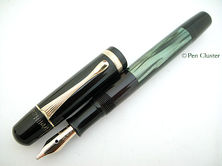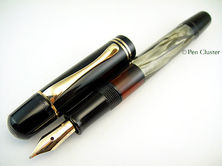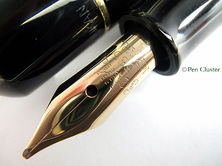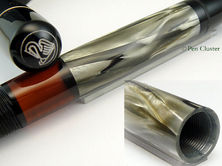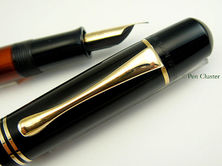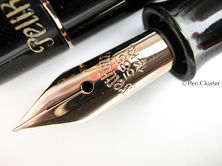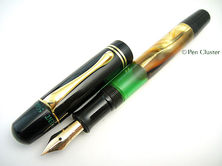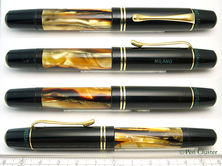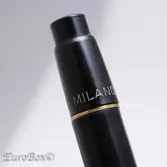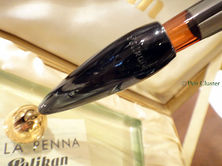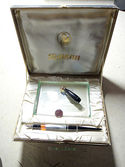top of page
Milan model - foreign production
There exist famous Pelikan pens, especially model 100N, called nowadays "Milan model" or "Milan style". These pens were produced by Milan factory in Italy, and are characterized most by the barrel. The colored celluloid is integral to the barrel and not an overlaid sleeve as had been the case with virtually every Pelikan pens made up to that time⁽¹⁾. Instead, the barrel is made from two pieces, one solid transparent part, one solid celluloid part. They are welded each other to be a single integrated celluloid for the barrel. The unusual nibs and imprints are also found with Milan model (Pelikan Schreibgeräte, Pelikan Pens: History).
Before WWII, Günter Wagner had many foreign factories (e.g. Danzig, Bucharest, Barcelona, Milan, Sofia, Vienna, Warsaw, Zagreb, Zürich, and throughout South America). Mainly they produced ink and office supplies. In every factories, however, there were pen repair facilities that had spare parts to avoid returning products to the production unit. In some factories, complete pens may have been assembled out of those parts (Pelikan Schreibgeräte, Pelikan Pens: History).
Towards the end of 1930's, celluloid came to dominate the pen manufacturing. Günter Wagner was not the exception. By 1939, hard rubber (ebonite) was gone from Pelikan pens (Pelikan Pens: History). Günter Wagner relocated its hard rubber machinery from Hannover to Milan in 1939 (Pelikan Pens: History), where local production started up. So, ebonite were used in Milan products (but not all pens). Milan factory produced not just standard pens, but a number of variants including desk pens (100S)⁽²⁾. Aa far as I confirmed, the features associated with Milan model (besides the characteristic barrel and "Milano" imprint) are "Germania" on the cap top, "14 kt", "585 ‰", "G.W." imprints on the nib, and heart-shaped hole in the nib, as shown in Figures⁽³⁾. According to Rick Propas, there exist Milano models with "Emege" imprints.
After WWII, foreign production was resumed in Milan factory (e.g. model 100S)⁽⁴⁾. But products in Milan factory proved to have major shortcomings for manufactural/technical reasons. Kovàcs had to go to Milan to solve the problems.
When model 400NN was introduced, matching desk pen (400S) was produced (or assembled) in Pelikan Milan factory. According to the local catalogues, this model was produced until at least 1962 (Pelikan-guide)⁽²⁾. Desk pens for model 140 and 120 were also produced (or assembled)(Pelikan-collectibles, Pelikan-collectibles). According to Pelikan Schreibgeräte, in 1958, model 355S, ballpoint pen with a long extension was developed upon request by Pelikan Milan.
It is not known when the Milan factory stopped producing writing instruments. At least until the 1980s, they made their own pens for the Italian market (Penboard.de).
Note;⁽¹⁾The barrel of marble color IBIS was similarly made.
⁽²⁾Desk pens manufactured in the Milan factory were differently named such as "100S" and "400S" (Pelikan-guide).
⁽³⁾These features are not necessarily exclusive for Milan model. For example, "Germania""585 ‰" imprint is found in normal barrel ("Germinia" imprint). According to Penboard.de, pens with normal barrel and "Germania" imprint was made in Germany for the Italian market.
⁽⁴⁾After WWII, foreign factories were expropriated by the authorities of that time. Some factories were closed down, while others continued to fountain pens, pencils, their spare parts, and inks (e.g. Milan, Zurich, Copenhagen, Barcelona, Amsterdam). However, royalty payments to Kovàcs by two foreign factories (Milan and ?) were refused. Finally, Kovàcs gave up and decide to sell his patens or manufacturing instructions, which may explain why Milan factory was able to to continue local fountain pen production (Pelikan Schreibgeräte, Pelikan Pens: History).
Pelikan 100N
Pelikan 100N
Pelikan 100N
Pelikan 100N
Pelikan 100N
Pelikan 100N short cap top
Pelikan 100S desk set
Pelikan 100S desk set
Please refer to the link for the English translation of the Italian catalog.

Pelikan 400S desk set
By courtesy of Christof Zollinger.
Pelikan 140 desk set (made in Milan)
bottom of page










